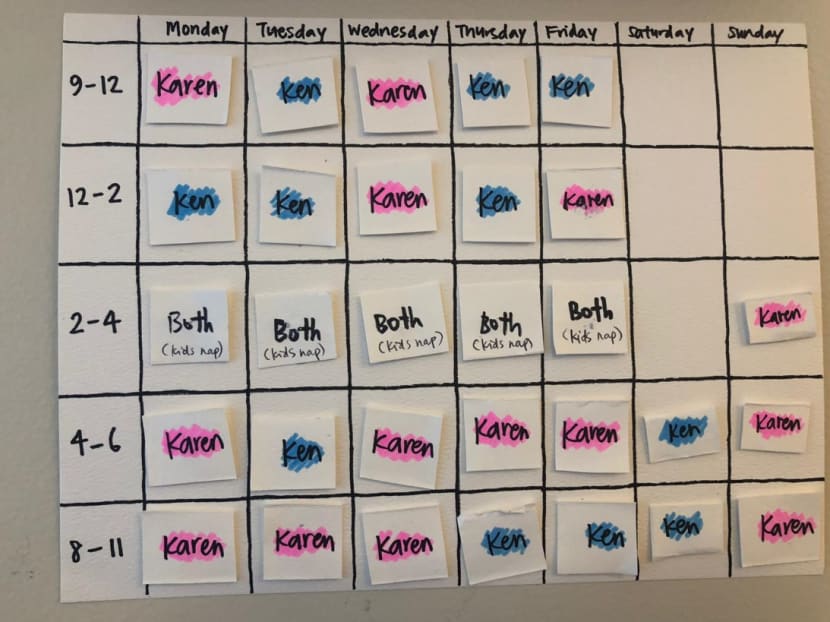Dealing with 4 challenges of telecommuting to keep teams well and effective
In the past three years, I’ve largely been a remote worker. Since many Singaporeans are now working remotely, I would like to share some tips on how leaders and employees can keep themselves and their teams healthy and effective while telecommuting.

The author, a mother of children aged four and two who has to work with colleagues across four time zones, shares some tips on how leaders and employees can keep themselves and their teams healthy and effective while working remotely.
In the past three years, I’ve largely been a remote worker.
I’m based in the San Francisco Bay Area, working for the Smart Nation and Digital Government Group as well as the Singapore Global Network. Both are part of the civil service, so their headquarters are naturally in Singapore.
I co-lead a global team spanning San Francisco, London, New York and Singapore. The four of us based in San Francisco have an office, but because our work usually takes us all over the country, we meet in person only once or twice a week.
Three weeks before Singapore’s circuit-breaker measures, the San Francisco Bay Area went into “shelter-in-place” mode. The conditions are relatively similar — all schools and childcare centers are closed, and we can step out of our homes only for essential services or exercise.
As a working mother of children aged four and two, whose husband also works, having children around 24/7 is an additional adjustment.
Since many Singaporeans are now working remotely, I would like to share some tips on how leaders and employees can keep themselves and their teams well and effective while working remotely.
Don’t take this as a prescriptive list — everyone has to make it work in their own way. I hope, however, that you find some of my experiences helpful.
1. CHALLENGE OF PSYCHOLOGICAL SAFETY
A few years ago, Google ran a study on what influences high performance in teams. One of the most important factors is psychological safety: A shared belief that team members can take risks, ask for help, and need not be afraid of looking stupid or bringing up difficult issues.
Achieving psychological safety is difficult as it is, much more so when working remotely. Without face-to-face interactions, bosses can be more worried if their staff are on top of things.
Employees may wonder if their boss acknowledges the work they are doing, or thinks they are slacking off. Depending on the original state of the relationship, the degree of stress varies.
What are some things that can help remote teams foster psychological safety?
First, it’s important to lean forward in gratitude and recognition. Bosses can send individual team members words of appreciation, and acknowledge the challenges they face.
This can be in the form of: “Thanks for the great presentation!” or “I know how hard you are working to manage this new project. It’s especially difficult when we’re all remote, since I know you rely on face-to-face interactions to build trust with the other team”.
Team mates can show more appreciation to each other, and to their bosses too.
When replying to emails, including a simple emoji can help better convey your actual tone.
If we are unhappy with someone, face-to-face interactions can smoothen some of these tensions easier.
In remote situations, I’ve found that clarifying quickly, setting expectations and avoiding accusations is especially important. A frame I use is “Situation, Behaviour, Impact, Expectation”.
For example: “We need this item for our management meeting on Friday. When you did not reply to my email for 24 hours, I felt nervous that there was no progress. In future, please drop me a quick update that you are working on it, and share your timelines.”
All these can enhance a climate of safety for your remote team.
2. THE CHALLENGE OF BLURRED WORK / LIFE BOUNDARIES
When working from home, there are fewer boundaries between work and life. I used to find myself working all the time, never really disconnecting from my devices — especially since I cover four time zones.
Additionally, if someone is insecure about his position with his boss, he might feel the need to immediately reply all the time. This can be detrimental to mental and emotional health.
What are some things that can help your team draw clearer work-life boundaries so that they can stay mentally and emotionally healthy?
First, try to schedule meetings as consistently as possible to provide structure to your days and weeks. For example, my operations meetings with the US, United Kingdom and Singapore are on Monday, Tuesday and Wednesday respectively.
Bi-weekly one-on-one meetings with team members are prescheduled for months. I still get asked to jump on last minute calls, but only those that are truly urgent.
Secondly, it is useful for bosses to be a role model in taking a break. For instance, message the team to say you are going for a run and will be online again in an hour or two. This simple act can make them feel freer to take their own breaks.
Thirdly, acknowledge that team members may have children at home, and find ways to accommodate one another. Since all schools and childcare centres are closed, my husband and I draw up a schedule to take turns with child care.

I communicate my working blocks with my team, and encourage them to come up with their own. We then try to accommodate each other’s boundaries when scheduling meetings.
When someone’s child wanders onto the screen, we say hello and show warmth — recognising each other as humans, not just workers.
3. THE CHALLENGE OF ORGANISATIONAL COLLABORATION AND CONNECTION
When teams work remotely, it’s common to fall into silos since interactions become more work-focused. What are some things that can enable organisational collaboration and connectedness for remote workers?
First, consciously invite people who work on adjacent issues into your team meetings. When working remotely, you might notice that meetings shrink to include only those who are absolutely essential. This is not a bad thing for productivity.
Counterbalance this occasionally by inviting other teams to a segment of your meeting. Share the notes with the wider organisation, if there’s nothing confidential.
If you are a boss, team members like to know what’s keeping their leaders busy. Where appropriate, forward emails which give them a sense of the broader organisational context.
Secondly, make it a routine to informally check in with people in your wider organisation.
I regularly WhatsApp call different people across my organisation for 15-minute chats just to ask how they’re doing and share what’s going on with my work.
It is a discipline which has helped me build relationships across the organisation despite being fully remote. Many “serendipitous” collaborations come from these informal check-ins.

The author, seen here doing a podcast, says she tries to introduce a non-work-related question at the start of her team meetings. Photo courtesy of Karen Tay
Finally, consider collaboration software. A big shift in my sense of connection came when we set up “Microsoft Teams” this January. The app organises various teams and projects into “chats”, which we can all access.
We can see people’s views and informal interactions on various issues, picking out what is relevant to ourselves. We can celebrate each other’s successes easier.
I find it a lot more effective than email in keeping track of organisational context. Slack is another option, and there are free versions.
4. THE CHALLENGES OF SOCIAL LIFE
Last but not least, workplaces are often a source of friendships and social life. It’s there where we understand how our team mates are doing, and provide mental and emotional support to one another in difficult times. I’ve found some effective ways in bringing this to the remote world.
During our regular team video calls, I’ve introduced a quick “social” question at the start such as: “What’s the song you listen to when you had a bad day?” or “What’s one thing you stress-ate recently?”
It only takes five minutes but we usually have a good laugh together before jumping into work. Several teammates have mentioned that they look forward to this personal connection at the start of our calls.
Since the Covid-19 crisis broke out, I have also made it a point to call my teammates on the front-lines for 15-minute chats once or twice a week.
The point is not to ask them about work, but to ask them how they are doing, how their families are, and anything else that they might like to share.
I have heard other ideas like having virtual team lunches. While these work for some, others, such as caregivers, might feel too time-strapped to participate. Giving people options is key.
These are difficult times for everyone. Many people are worried for their loved ones who are vulnerable or have lost their jobs. Others have children at home 24/7.
Having a psychologically safe workplace that promotes mental and emotional wellbeing, organisational collaboration, and social connection will help your team weather this season well.
This can be an incredible opportunity to become even more human in how we interact with one another, and this will make for a stronger team and organisation when things go back to normal.
ABOUT THE AUTHOR:
Karen Tay is a director in the Smart Nation and Digital Government Group (Prime Minister's Office) and Regional Vice President in the Singapore Global Network (Economic Development Board).






